EO12866_Oil and Gas Review 2060-AT90 Draft Supporting Statement20190827
EO12866_Oil and Gas Review 2060-AT90 Draft Supporting Statement20190827.docx
Oil and Natural Gas Sector: Emission Standards for New, Reconstructed, and Modified Sources Review (Proposed Rule)
OMB: 2060-0729
SUPPORTING STATEMENT
Oil and Natural Gas Sector: Emission Standards for New, Reconstructed, and Modified
Sources Review (40 CFR part 60, subpart OOOOa)
(Proposed Amendments As A Result of Review Under Executive Order 13783)
PART A
1.0 Identification of the Information Collection
(a) Title and Number of the Information Collection.
The title of the Information Collection Request (ICR) is Oil and Natural Gas Sector: Emission Standards for New, Reconstructed, and Modified Sources Review (40 CFR part 60, subpart OOOOa), U.S. Environmental Protection Agency (EPA) tracking number 2604.01, Office of Management and Budget (OMB) Control Number 2060-NEW.
(b) Short Characterization.
On June 3, 2016, EPA published a final rule titled “Oil and Natural Gas Sector: Emission Standards for New, Reconstructed, and Modified Sources; Final Rule,” at 81 FR 35824 (2016 NSPS OOOOa). The rule established New Source Performance Standards (NSPS) for greenhouse gas and volatile organic compound (VOC) emissions from the oil and natural gas sector.
Following promulgation of the final rule, the Administrator received petitions for reconsideration of several provisions of the 2016 NSPS OOOOa. The EPA addressed those specific reconsideration issues in a separate proposal published on October 15, 2018 (2018 NSPS OOOOa Reconsideration Proposal).a
On March 28, 2017, President Donald Trump issued Executive Order (EO) 13783, entitled “Promoting Energy Independence and Economic Growth,” which directs agencies to review existing regulations that potentially burden the development of domestic energy resources, and appropriately suspend, revise, or rescind regulations that unduly burden the development of U.S. energy resources beyond what is necessary to protect the public interest or otherwise comply with the law. The EPA is proposing amendments to subpart OOOOa as a result of this EO 13783 review (2019 NSPS OOOOa EO 13783 Review Proposal). Specifically, if finalized, the proposed amendments as a result of the EPA’s EO 13783 review would:
Remove sources in the transmission and storage segment from the source category and rescind the NSPS requirements applicable to those sources, and
Rescind the methane requirements of the NSPS applicable to sources in the production and processing segments.
As an alternative proposal, the EPA is proposing to rescind the methane requirements of the NSPS applicable to all oil and natural gas sources and not amending the source category.
This ICR estimates the information collection burden for NSPS OOOOa considering the proposed amendments in 2019 NSPS OOOOa EO 13783 Review Proposal. The estimates presented in the body of this document reflect the impacts of NSPS OOOOa assuming a combination of the amendments contained in the 2018 NSPS OOOOa Reconsideration Proposal and the amendments in the 2019 NSPS OOOOa EO 13783 Review Proposal.b,c In addition, the burden is estimated without consideration of the 2018 proposed amendments and presented in an Appendix.
The affected respondents are owners or operators of onshore oil and natural gas affected facilities (40 CFR 60.5365a). For the purposes of this ICR, it is assumed that all oil and natural gas affected facilities located in the U.S. are owned and operated by the oil and natural gas industry (the “Affected Public”) and none of the affected facilities in the U.S. are owned or operated by state, local, tribal or the Federal government. All affected facilities are assumed to be privately owned for-profit businesses.
This ICR estimates that an average of 3,648 respondents will be affected over the three-year period (2019-2021). The average annual burden for the recordkeeping and reporting requirements for these owner and operators is 230,285 person-hours, with an average annual cost of $14,177,438 over the three-year period (2019-2021). This represents a burden reduction of 2 percent compared to the burden estimated for the 2016 NSPS OOOOa (see Appendix A). This represents a burden reduction of 16 percent compared to the 2018 NSPS OOOOa Reconsideration Proposal amendments (see Appendix B). The burden associated with strictly the 2019 NSPS OOOOa EO 13783 Review Proposal is presented in Appendix C.
2. Need For and Use of the Collection
(a) Need/Authority for the Collection.
EPA is charged under section 111 of the Clean Air Act (CAA), as amended, to establish standards of performance for new stationary sources that reflect:
. . . application of the best technological system of continuous emissions reduction which (taking into consideration the cost of achieving such emissions reduction, or any non-air quality health and environmental impact and energy requirements) the Administrator determines has been adequately demonstrated. Section 111(a)(l).
The Agency refers to this charge as selecting the best system of emissions reduction (BSER). Section 111 also requires that the Administrator review and, if appropriate, revise such standards every 8 years.
In addition, section 114(a) of the CAA states that the Administrator may require any owner or operator subject to any requirement of this Act to:
establish and maintain such records;
make such reports;
install, use, and maintain such monitoring equipment;
use such audit procedures, or methods;
sample such emissions (in accordance with such procedures or methods, at such locations, at such intervals, during such periods, and in such manner as the Administrator shall prescribe);
keep records on control equipment parameters, production variables or other indirect data when direct monitoring of emissions is impractical;
submit compliance certifications in accordance with section 114(a)(3); and
provide such other information as the Administrator may reasonably require.
The information collection activities being proposed represent a reduction in the burden associated with recordkeeping and reporting requirements under NSPS OOOOa and are the minimum necessary for the Administrator to confirm the compliance status of new and modified oil and natural gas affected facilities. These recordkeeping and reporting requirements are authorized by CAA section 114.
(b) Practical Utility/Users of the Data.
The information collected will be used by the delegated authority (state agency, or Regional Administrator if there is no delegated state agency) to ensure that the standards and other requirements of subpart OOOOa are being achieved. Based on review of the recorded information at the site and the reported information, the delegated permitting authority can identify affected facilities that may not be complying and decide which affected facilities, records, or processes may need inspection.
3. Nonduplication, Consultations, and Other Collection Criteria
(a) Nonduplication.
The information-gathered under this ICR will replace the information gathered under the rule prior to being amended. The recordkeeping and reporting requirements for the 2016 NSPS OOOOa were developed following similar reporting requirements as outlined in “Mandatory Reporting of Greenhouse Gases: Subpart W Oil and Natural Gas” in 40 CFR 98.2 and 40 CFR 98.4. By remaining consistent with subpart W, EPA minimized the burden required to monitor and show compliance. In addition, if a State or local agency has adopted their own similar standards to implement the Federal standards, a copy of the report submitted to the state or local agency can be sent to the Administrator in lieu of the report required by the Federal standards.d Therefore, no duplication exists. The proposed deregulatory amendments addressed by this ICR further reduces the burden and potential for duplication of recordkeeping and reporting requirements under NSPS OOOOa.
(b) Public Notice Required Prior to ICR Submission to OMB.
The preamble for the proposed deregulatory amendments as a result of EPA’s EO 13783 review provides public notice of this proposed ICR. EPA will consider comments when preparing the revised ICR and the preamble to the final rule will provide public notice on the revised ICR.
(c) Consultations.
In developing the 2016 NSPS OOOOa, the 2018 NSPS OOOOa Reconsideration Proposal, and the 2019 NSPS OOOOa EO 13783 Review Proposal, the EPA performed a comprehensive review of existing state rules and industry standards, visited oil and natural gas sites, and consulted with individual companies, state agencies, and environmental groups. The main organizations that provided expert advice during the development of this rule include the Agency’s industry experts. Stakeholder meetings and contacts are documented in the docket for the 2016 final rule (Docket No. EPA-HQ-OAR-2010-0505), the docket for the 2018 NSPS OOOOa Reconsideration Proposal (Docket No. EPA-HQ-OAR-2017-0483), and the docket for the 2019 NSPS OOOOa EO 13783 Review Proposal (Docket No. EPA-HQ-OAR-2017-0757).
(d) Effects of Less Frequent Collection.
Respondents must monitor all specified criteria at each affected facility and maintain these records for 2 years, as specified under 40 CFR 60.7. The reporting frequency to EPA has been established/amended to minimize the burden on owners and operators of affected facilities. If the information required by NSPS OOOOa were collected less frequently, the likelihood of detecting violations would be reduced.
(e) General Guidelines.
This collection of information is consistent with all OMB guidelines established by OMB at 5 CFR part 1320, section 1320.5.
(f) Confidentiality.
All information submitted to the Agency for which a claim of confidentiality is made will be safeguarded according to EPA regulations set forth in 40 CFR 2.201 et seq., Chapter 1, Part 2, Subpart B-Confidentiality of Business Information.
(g) Sensitive Questions.
This section is not applicable because this ICR does not involve matters of a sensitive nature.
4. The Respondents and the Information Requested
(a) Respondents/NAICS Codes.
Potential respondents after the proposed amendments to NSPS OOOOa would be owners or operators of new, modified or reconstructed oil and natural gas affected facilities as defined under the rule. The North American Industry Classification System (NAICS) codes for the oil and gas industry include: 211120 (Crude Petroleum Extraction); 211130 (Natural Gas Extraction); 221210 (Natural Gas Distribution); 486110 (Pipeline Distribution of Crude Oil); 486210 (Pipeline Transportation of Natural Gas).
(b) Information Requested.
(i) Data Items, Including Recordkeeping Requirements
Recordkeeping |
|
For well affected facilities, record location and well identification information. Maintain completion log records for each completion operation. For wells exempt from one or more requirements, maintain records to support exemption. |
60.5375a(b); 60.5410a(a); 60.5415a(a); 60.5420a(c)(1) |
For well affected facilities with ≤300 scf of gas per stock tank barrel of oil produced, keep records to demonstrate exemption. |
60.5375a(g)(2); 60.5420a(c)(1)(vi). |
For pneumatic pump affected facilities that are not controlled, maintain information related to equipment, purchase, location, and manufacturer specifications. Prepare and submit applicable certification and maintain records. Maintain information related to equipment, purchase, location, and manufacturer specifications. |
60.5393a(b)(3)-(5); 60.5393a(e); 60.5410a(e)(8); 60.5420a(c)(16) |
For pneumatic pump affected facilities that are controlled, maintain information related to equipment, purchase, location, manufacturer specifications, and control. Maintain certification of CVS capacity; record results of CVS and by-pass inspections, maintenance, and corrective actions. |
60.5393a(c), (e); 60.5410a(e)(8); 60.5420a(c)(16); 60.5411a(c)(3)(i)(A); 60.5411a(d); 60.5416a(c); 60.5420a(c)(6)-(8), (16) and (17). |
For storage vessel affected facilities, maintain compliance records for control device including visible emission observation results, inspection results, corrective actions, and maintenance. Maintain certification of CVS capacity; record results of CVS and by-pass inspections, maintenance, and corrective actions. |
60.5395a(d)(3); 60.5411a(c)(3)(i)(A); 60.5411a(d); 60.5412a(c) and (d); 60.5413a(d) and (e); 60.5416a(c); 60.5417a(h)60.5420a(c)(5)-(8), (12)-(14), and (17). |
For affected facilities at onshore gas processing plants, records of subject equipment, records of leak detection and repair program. |
60.5400a(a), 60.482-1a(b) and (d); 60.482-7a; 60.482-10a |
For sweetening unit affected facilities at onshore natural gas processing plants, records of sulfur levels, acid gas, calculations, measurements, and compliance records. |
60.5407a(a); 60.5423a |
Notifications and Reporting |
|
Notify the Administrator at least two days prior to a well completion operation. |
60.5420a(a)(2) |
Submit an annual report, per operating entity, for all wellhead, pneumatic controller, pneumatic pump, storage vessel, centrifugal and reciprocating compressor affected facilities. |
60.5420a(b) |
Notification of construction or reconstruction. |
60.7(a)(1) |
Notification of performance test. |
60.8(d) |
Annual reports including those of excess emissions. |
60.5417a(c); 60.487a(c)( 2)(i)-(vi) |
Performance test results. |
60.487a(e) |
Semiannual report on excess emissions from and performance of continuous monitoring system, and/or summary report forms at processing plants. Annual report on excess emissions from and performance of continuous monitoring system for sweetening units. |
60.5422a(b), 60.5410a(g)(3); 60.5423a(b) |
|
|
(ii) Respondent Activities
Respondent Activities |
Read instructions/rule. |
Gather relevant information. |
Perform initial performance test and repeat performance tests if necessary. |
Write the notifications and reports listed above. |
Enter information required to be recorded above. |
Submit the required reports developing, acquiring, installing, and utilizing technology and systems for the purpose of collecting, validating, and verifying information. |
Develop, acquire, install, and utilize technology and systems for the purpose of processing and maintaining information. |
Develop, acquire, install, and utilize technology and systems for the purpose of disclosing and providing information. |
Adjust the existing ways to comply with any previously applicable instructions and requirements. |
Train personnel to be able to respond to a collection of information. |
Transmit, or otherwise disclose the information. |
5. The Information Collected–Agency Activities, Collection Methodology, and Information Management
(a) Agency Activities.
The combined Federal government (EPA) burden of NSPS OOOOa after the 2018 NSPS OOOOa Reconsideration Proposal amendments and the 2019 NSPS OOOOa EO 13783 Review Proposal amendments are shown in Tables 2a-2d (located at the end of this supporting statement). The 2019 NSPS OOOOa EO 13783 Review Proposal amendments would reduce the burden associated due to the removal of requirements for sources in the transmission and storage segment, but these amendments do not impact the estimated burden on the Federal government (EPA) estimated for the 2018 NSPS OOOOa Reconsideration Proposal.
(b) Collection Methodology and Management.
Data and records maintained by the respondents will be tabulated and published for use in compliance and enforcement programs of the delegated permitting authority. Information contained in the reports will be required to submit records electronically to EPA’s Central DATA Exchange (CDX) using the Compliance and Emissions Data Reporting Interface (CEDRI). CDX enables fast, efficient and more accurate environmental data submissions from state and local governments, industry and tribes to EPA and participating program offices. EPA's CDX is the point of entry on the Environmental Information Exchange Network (Exchange Network) for environmental data submissions to the Agency. CDX works with both EPA program offices looking for a way to better manage incoming data, and stakeholders looking for a way to reduce burden from reporting requirements.
(c) Small Entity Flexibility.
The proposed amendments represent a deregulatory action, and the burden on all entities affected by the proposed amendments to NSPS OOOOa, including small entities, is reduced compared to the 2016 NSPS OOOOa. Therefore, the proposed amendments will relieve regulatory burden for all directly-regulated small entities.
(d) Collection Schedule.
The specific frequency for each information collection activity within this request is shown in Tables 1a-1d.
6. Estimating the Burden and Cost of the Collection
(a) Estimating Respondent Burden.
The combined respondent burden of NSPS OOOOa if the 2018 NSPS OOOOa Reconsideration Proposal amendments and the 2019 NSPS OOOOa EO 13783 Review Proposal amendments are finalized are shown in Tables 1a-1d. These numbers are based on the estimated number of affected facilities that would be subject to the requirements of the NSPS from years 2019 to 2021, if both sets of proposed amendments are finalized.
(b) Estimating Respondent Costs.
(i) Estimating Labor Costs.
This ICR uses the following labor rates: $60.56 per hour for technical labor, $123.27 per hour for management labor, and $40.72 for clerical labor. These rates include an increase of 110 percent to account for the benefit packages available to those employed by private industry. These rates are from the May 2016 National Occupational Employment and Wage Estimates United States published by the Bureau of Labor and Statistics (https://www.bls.gov/oes/current/oes_nat.htm). Costs have been estimated in 2016 dollars for this ICR, which is consistent with the costs (i.e. cost of control) estimated in the supporting documents developed for the proposed amendments to subpart OOOOa.
The information collection activities for the amended NSPS OOOOa are presented in Tables 1a-1d. Because the data are already collected by respondents as part of normal operations, no respondent costs are associated with information collection activities.
(ii) Estimating Capital and Operations and Maintenance (O&M) Costs. The EPA estimates that there will not be additional capital and O&M monitoring costs for newly affected facilities as a result of EPA’s proposed deregulatory amendments under EO 13783.
(c) Estimating Agency Burden and Cost.
Because reporting and recordkeeping requirements on the part of the respondents are required under the operating permits rules in 40 CFR part 70 or part 71 and the part 60 NSPS General Provisions, no operational costs will be incurred by the Federal Government. Publication and distribution of the information are part of the Compliance Data System, with the result that no Federal costs can be directly attributed to the ICR. Examination of records to be maintained by the respondents will occur incidentally as part of the periodic inspection of facilities that is part of EPA’s overall compliance and enforcement program, and, therefore, is not attributable to the ICR. The only costs that the Federal government will incur are user costs associated with the analysis of the reported information, as presented in Tables 2a-2d.
This cost is based on the average hourly labor rate as follows:
Managerial $64.16 (GS-13, Step 5, $38.92 + 60%)
Technical $47.62 (GS-12, Step 1, $28.88 + 60%)
Clerical $25.76 (GS-6, Step 3, $15.63 + 60%)
These rates are from the Office of Personnel Management (OPM), 2016 General Schedule rates of pay, which excludes locality. The rates have been increased by 60 percent to account for the benefit packages available to government employees. Costs have been estimated in 2016 dollars for this ICR to be consistent with other costs (i.e., cost of control) estimated in the development of subpart OOOOa.
(d) Estimating the Respondent Universe and Total Burden and Costs.
It was estimated that an average of 3,648 respondents per year will be subject to NSPS OOOOa during the 3-year period of this ICR as shown in the following table below. This estimate encompasses the number of companies that the EPA expects will submit reports separately as its own entity. The average annual number of respondents per year is calculated using the following table.
Year |
Annual Number of Respondents |
1 |
3,428 |
2 |
3,648 |
3 |
3,868 |
Average |
3,648 |
For NSPS OOOOa, the components of the total annual responses attributable to this ICR are notifications of well completions/recompletions from an average of 2,328 companies over the three-year period, notification of construction, reconstruction and modification from an average of 8 companies over the three-year period, annual reports from an average of 3,606 companies over the three-year period, and semiannual reports from an average of 42 companies over the three-year period. (Processing facilities report semiannually, all others annually).
The average number of annual responses per year is calculated using the following table.
Total Annual Responses |
|||
Information Collection Activity |
Number of Respondentsa |
Number of Responses |
Total Annual Responses |
Notification of well completions/recompletions |
2,328 |
1 |
2,328 |
Notification of construction/reconstruction/modification |
8 |
1 |
8 |
Annual Compliance Reports |
3,606 |
1 |
3,606 |
Semiannual Compliance Reports |
42 |
2 |
84 |
Total |
6,026 |
||
aThe EPA assumes each facility will make the appropriate notifications and that each respondent will submit the annual or semiannual report for all affected facilities in each year.
(e) Bottom-Line Burden Hours and Cost Tables.
(i) Respondent tally. The bottom-line respondent burden hours and costs for the three years (2019-2021) covered by this ICR are presented in Table 1d (located at the end of this supporting statement). The average annual burden for the recordkeeping and reporting requirements in this ICR for the estimated 3,648 respondents that are subject to the rule is 230,285 labor hours, with an annual average cost of $14,177,438. The average annual burden represents the hours and costs for respondents in production and processing, which is the only segment that would be have an estimated burden if the 2019 NSPS OOOOa EO 13783 Review Proposal amendments are finalized.
(ii) The Agency Tally. The average annual Federal Government cost is $788,398 for 16,679 labor hours for subpart OOOOa. The bottom-line Agency burden hours and costs, presented in Table 2d, are calculated from Tables 2a-2c by adding person-hours per year down each column for technical, managerial, and clerical staff, and by adding down the cost column.
(iii) Variations in the annual bottom line. This section does not apply since no significant variation is anticipated.
(f) Reasons for Change in Burden.
(i) 2016 NSPS ICR Updated Baseline. The original burden estimated for the 2016 NSPS OOOOa (ICR EPA tracking number 2523.02) was modified to reflect updates to the estimated number of affected facilities according to the 2018 Inventory of U.S. Greenhouse Gas Emissions and Sinks (GHGI) and, for storage vessels, updated activity numbers included in the “Oil and Natural Gas Sector: Emission Standards for New, Reconstructed, and Modified Sources. Background Technical Support Document for the Proposed Reconsideration of the New Source Performance Standards, 40 CFR Part 60, subpart OOOOa. September 2018.” The original 2016 NSPS OOOOa burden did not include the recordkeeping and reporting burden associated with the fugitives program in the bottom line numbers. In the 2016 NSPS ICR updated baseline, the cost and hour burden related to the fugitives program has been included. The 3-year annual average estimated for the 2016 NSPS ICR Updated Baseline was 274,291 hours and $16,886,648 ($2016). The annual burden estimated for the 2016 NSPS ICR Updated Baseline is shown in Appendix A.
(ii) 2018 NSPS OOOOa Reconsideration Proposal. The 3-year annual average estimated for NSPS OOOOa assuming the 2018 NSPS OOOOa Reconsideration Proposal amendments are finalized was 236,334 hours and $236,334 ($2016). This estimate includes the recordkeeping and reporting burden associated with the fugitives program. The annual burden estimated for NSPS OOOOa if only the 2018 NSPS OOOOa Reconsideration Proposal amendments are finalized is shown in Appendix B. In the 2018 NSPS OOOOa Reconsideration Proposal, the EPA proposed amendments to address issues raised in petitions and proposed amendments to provide clarity, streamlining and alignment of requirements leading to an overall burden reduction to the regulated community.
(iii) 2019 NSPS OOOOa EO 13783 Review Proposal. The 3-year annual average estimated for NSPS OOOOa assuming the 2019 NSPS OOOOa EO 13783 Review Proposal amendments are finalized and if the 2018 NSPS OOOOa Reconsideration Proposal amendments are also finalized, is 230,285 labor hours, with an annual average cost of $14,177,438. The proposed amendments based on a review of the 2018 NSPS OOOOa Reconsideration Program under EO 13783 result in additional reductions in the labor burden hours and costs from what was estimated for the 2018 NSPS OOOOa Reconsideration Proposal. This reduction is attributed to the proposed removal of the transmission and storage segment from the source category and associated affected facility recordkeeping and reporting requirements affecting the following units in years 2019-2021:
Centrifugal Compressors
Reciprocating Compressors
Pneumatic Controllers
In the absence of changes associated with the 2019 NSPS OOOOa EO 13783 Review Proposal amendments, the EPA estimated that the number of new affected units in the transmission and storage segment would have been subject to recordkeeping and reporting requirements in the 3-year period between 2019 and 2021. These estimates are presented below.
Source |
Number of New Affected Facilities per year in Transmission and Storagea, b, c |
||
Year 1 (2019) |
Year 2 (2020) |
Year 3 (2021) |
|
Centrifugal Compressors |
90 |
108 |
126 |
Reciprocating Compressors |
380 |
456 |
532 |
Pneumatic Controllers |
308 |
308 |
308 |
Total Labor Hours |
3,588 |
3,951 |
4,315 |
Total Labor Cost ($2016) |
$220,894 |
$243,267 |
$265,639 |
aThe number of new affected facilities per year obtained from the memorandum entitled “Draft Estimate of New Sources Affected for purposes of the Information Collection Request under the Proposed Amendments to 40 CFR Part 60, Subpart OOOOa” (Appendix D).
bAs year 2015 as the starting point, it is estimated that 18 new centrifugal compressors, 76 reciprocating compressors, and 308 pneumatic controllers in the transmission and storage segment will be affected annually.
cRecordkeeping and reporting activities for controllers are assumed to be a one-time occurrence per controller and not a repeated annual activity.
Because the 2019 NSPS OOOOa EO 13783 Review Proposal amendments would remove the transmission and storage segment from the source category, labor hours and costs associated with the current requirements that apply to centrifugal compressors, reciprocating compressors, and pneumatic controllers that are present in the transmission and storage segment would be eliminated.
3-year Annual Average (2019-2021) |
|||||
3-year (2019-2021) |
2016 NSPS OOOOa Updated Baseline |
2019 NSPS OOOOa EO 13783 Proposal Only |
2018 NSPS OOOOa Proposal Only |
2018 NSPS OOOOa Proposal + 2019 NSPS OOOOa EO 13783 Proposal |
|
Average Labor Hours |
274,491 |
267,718 |
236,334 |
230,285 |
|
Average Labor Costs ($2016) |
$16,886,648 |
$16,481,959 |
$14,549,843 |
$14,177,438 |
|
% Reduction from 2016 NSPS OOOOa Updated Baseline |
2% |
|
|||
% Reduction from 2016 Updated Baseline + 2018 NSPS OOOOa Proposal |
16% |
|
|||
As the above table shows, , the 2019 NSPS OOOOa EO 13783 Review Proposal represents a 2 percent burden reduction compared to the updated 2016 NSPS OOOOa baseline.e This burden reduction equates to an overall reduction of 6,773 average annual labor hours and represents a decrease in average total annual respondent burden cost for reporting and recordkeeping of $404,689 ($2016) in the 3-year average. The 2019 NSPS OOOOa EO 13783 Review Proposal in combination with the 2018 NSPS OOOOa proposal represents a burden reduction of 16 percent compared to the 2016 Updated Baseline. This burden reduction equates to an overall reduction of 44,206 average annual labor hours and represent a cost decrease on average of $2,709,210.
(g) Burden Statement
The annual public reporting and recordkeeping burden for this collection of information is estimated to average 49 hours per response. Burden means the total time, effort, or financial resources expended by persons to generate, maintain, retain, or disclose or provide information to or for a Federal agency. This includes the time needed to review instructions; develop, acquire, install, and utilize technology and systems for the purposes of collecting, validating, and verifying information, processing and maintaining information, and disclosing and providing information; adjust the existing ways to comply with any previously applicable instructions and requirements; train personnel to be able to respond to a collection of information; search data sources; complete and review the collection of information; and transmit or otherwise disclose the information.
An agency may not conduct or sponsor, and a person is not required to respond to, a collection of information unless it displays a valid OMB Control Number. The OMB Control Numbers for EPA regulations are listed at 40 CFR part 9 and 48 CFR chapter 15.
To comment on the Agency's need for this information, the accuracy of the provided burden estimates, and any suggested methods for minimizing respondent burden, including the use of automated collection techniques, EPA has established a public docket for this ICR under Docket ID Number EPA-HQ-OAR-2017-0757. An electronic version of the public docket is available at http://www.regulations.gov/ which may be used to obtain a copy of the draft collection of information, submit or view public comments, access the index listing of the contents of the docket, and to access those documents in the public docket that are available electronically. When in the system, select “search,” then key in the docket ID number identified in this document. The documents are also available for public viewing at the Enforcement and Compliance Docket and Information Center in EPA Docket Center (EPA/DC), EPA WJC West Building, Room 3334, 1301 Constitution Ave., NW, Washington, DC. EPA Docket Center Public Reading Room is open from 8:30 a.m. to 4:30 p.m., Monday through Friday, excluding legal holidays. The telephone number for the Reading Room is (202) 566-1744, and the telephone number for the Enforcement and Compliance Docket and Information Center is (202) 566-1742. Also, you can send comments to the Office of Information and Regulatory Affairs, Office of Management and Budget, 725 17th Street, NW, Washington, DC 20503, Attention: Desk Officer for EPA. Please include EPA Docket ID Number EPA-HQ-OAR-2017-0757 in any correspondence.
PART B
This section is not applicable because statistical methods are not used in data collection associated with the final rule.
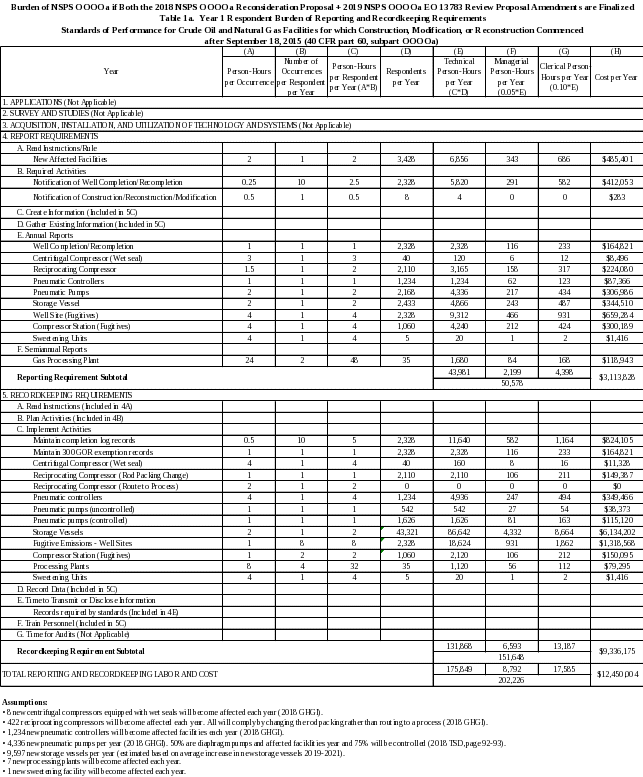
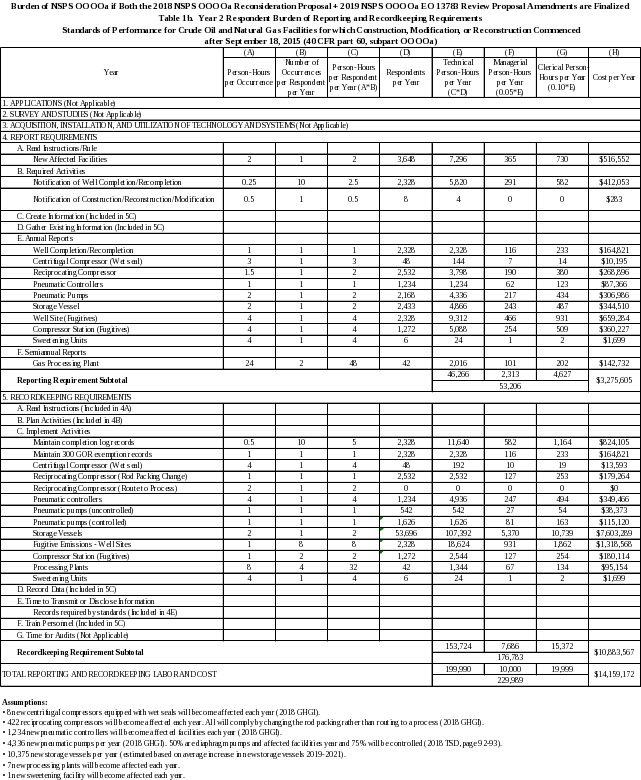





 Appendix
A
Appendix
A
Updated ICR Burden of 2016 NSPS OOOOa
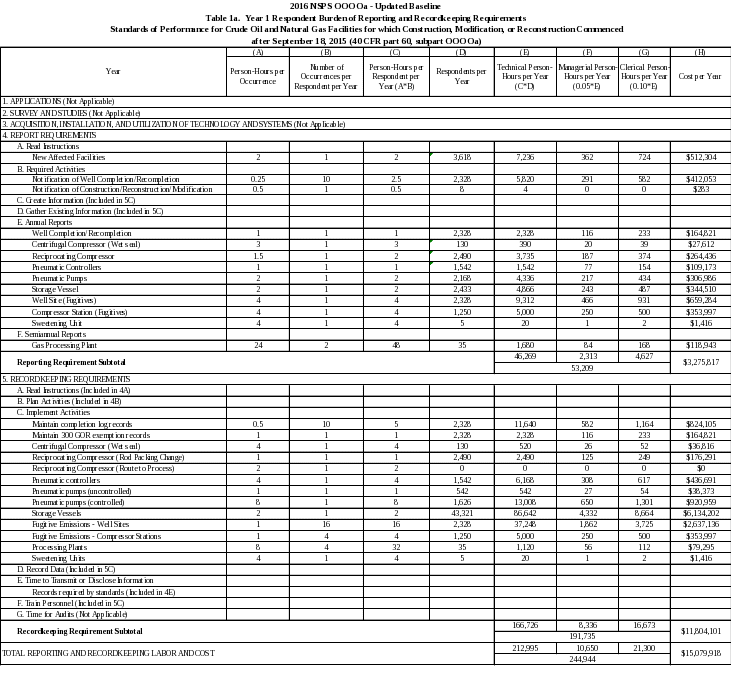
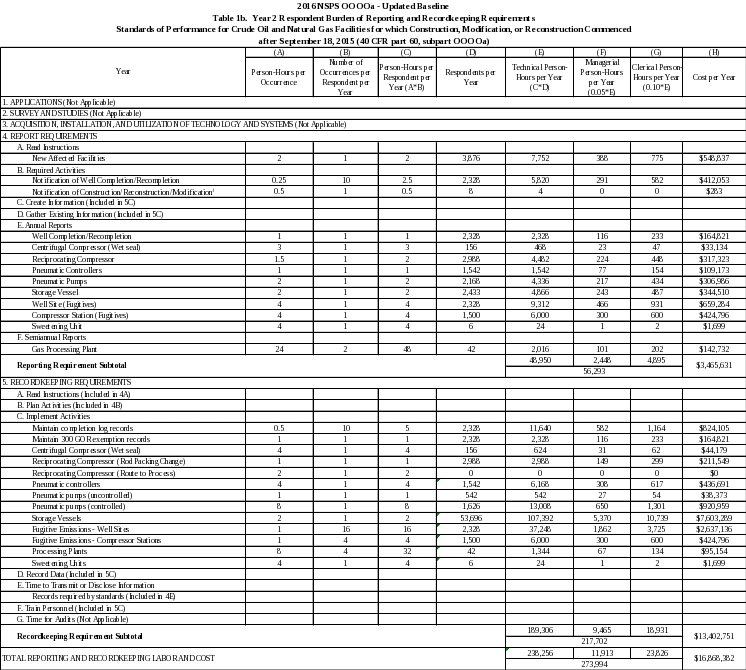
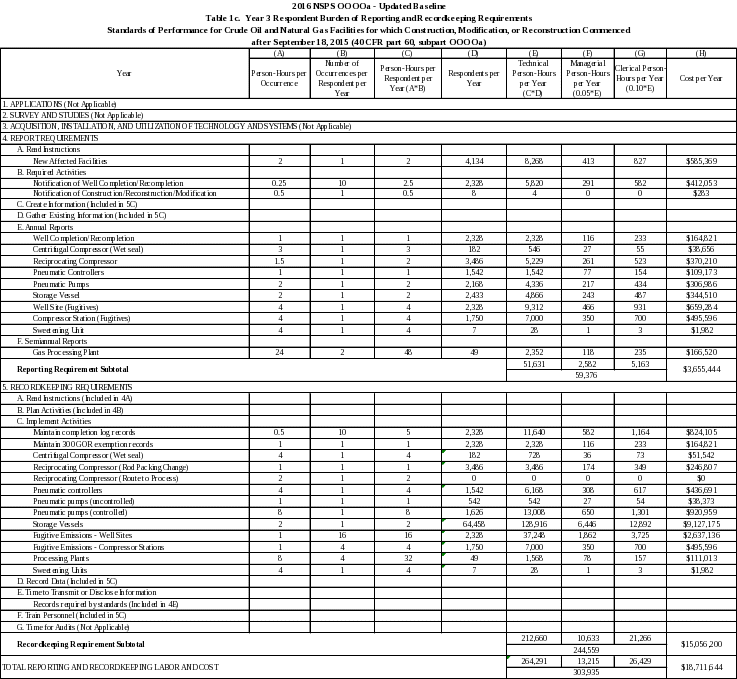

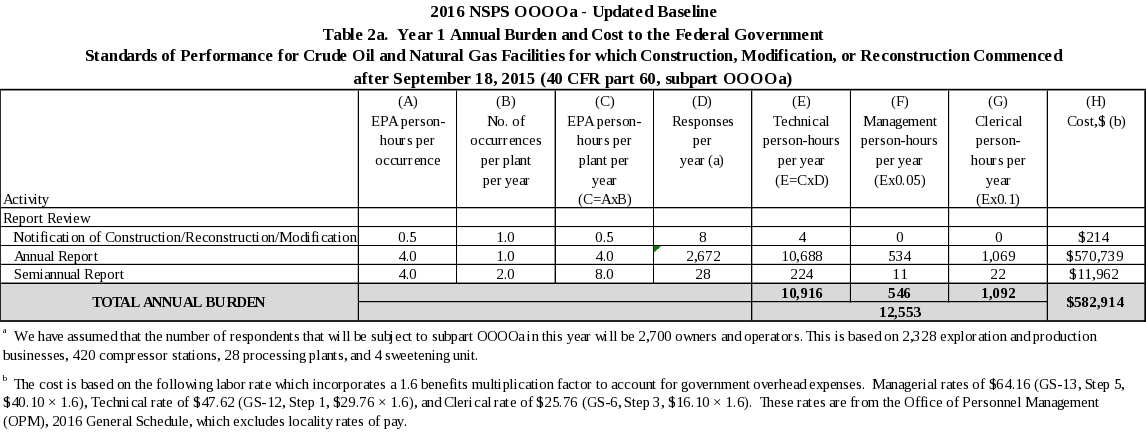
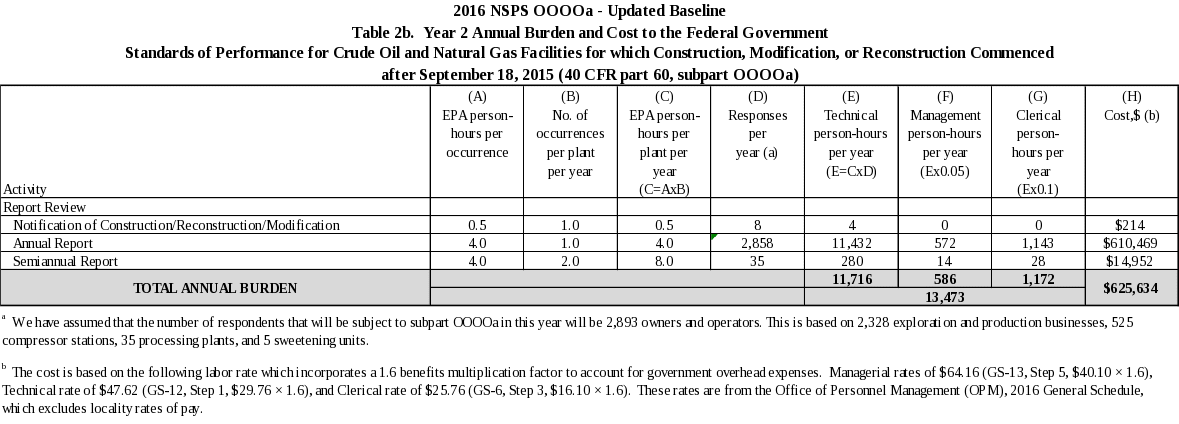
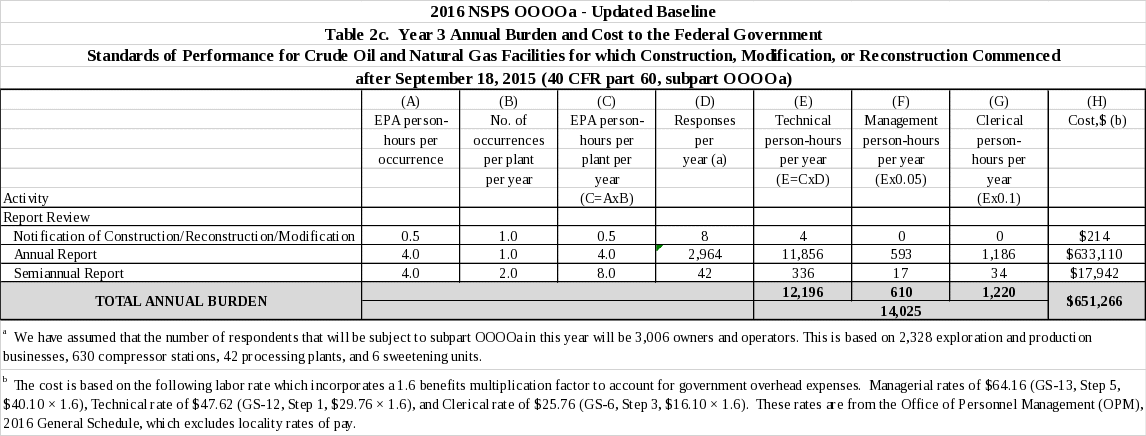

Appendix B
Updated ICR Burden of NSPS OOOOa Assuming the 2018 NSPS OOOOa Reconsideration Proposal Amendments are Finalized (Does Not Consider the Impacts of the 2019 NSPS OOOOa EO 13783 Proposed Amendments)
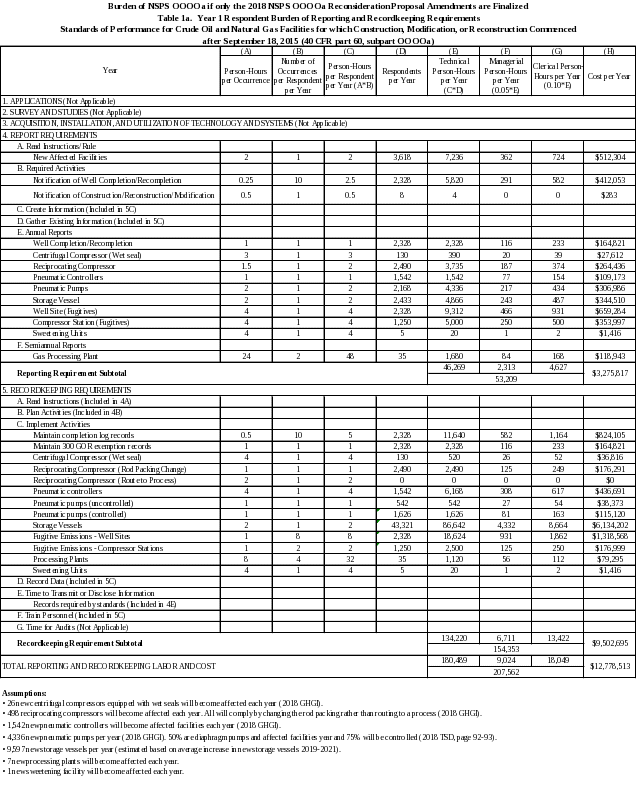

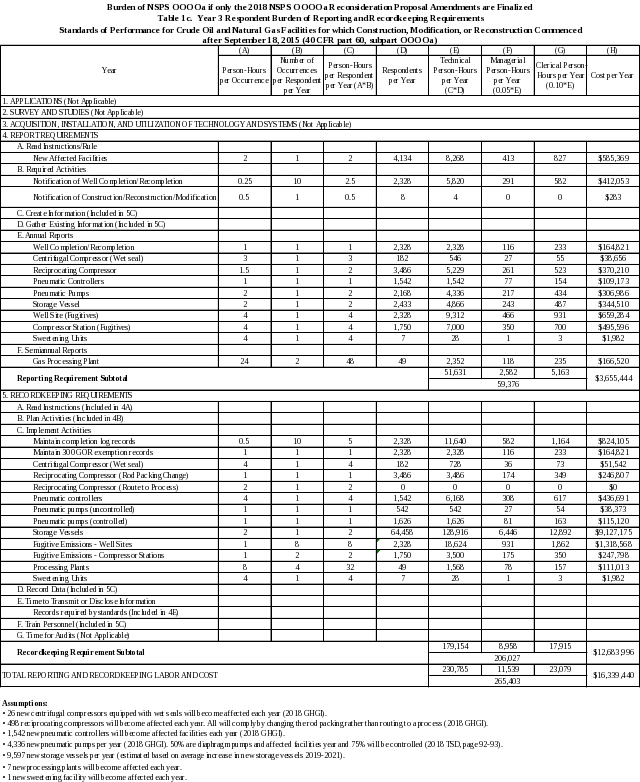


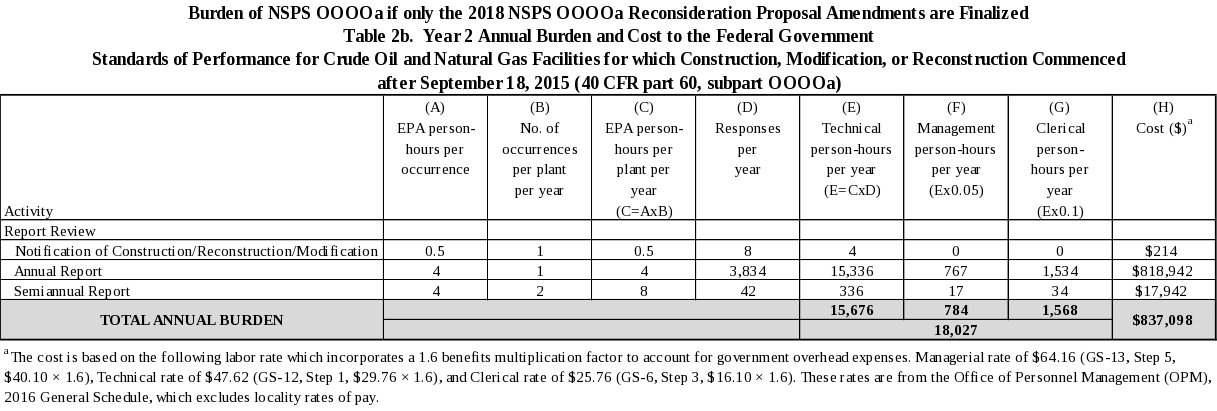
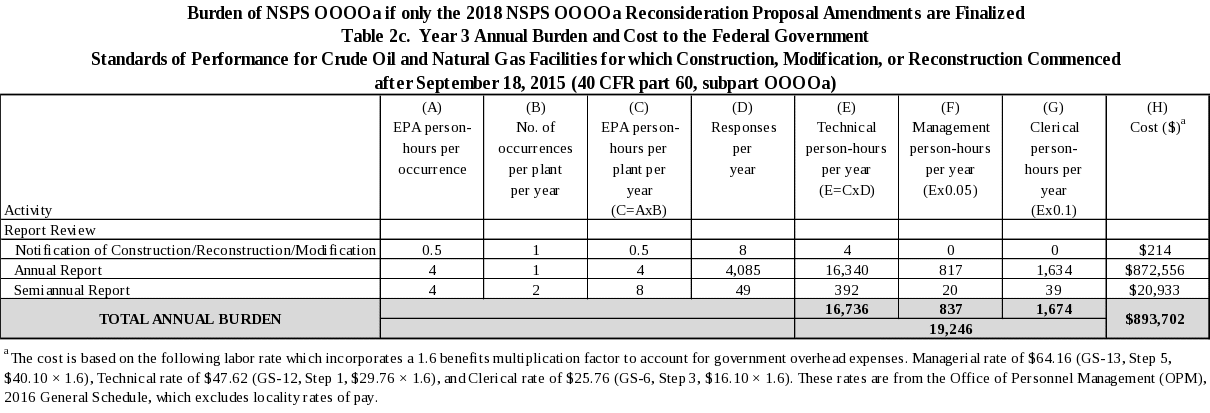
 Appendix
C
Appendix
C
Updated ICR Burden of NSPS OOOOa Assuming the 2019 NSPS OOOOa EO 13783 Review Proposal Amendments are Finalized Only (Does Not Consider the Impacts of the 2018 NSPS OOOOa Reconsideration Proposed Amendments)




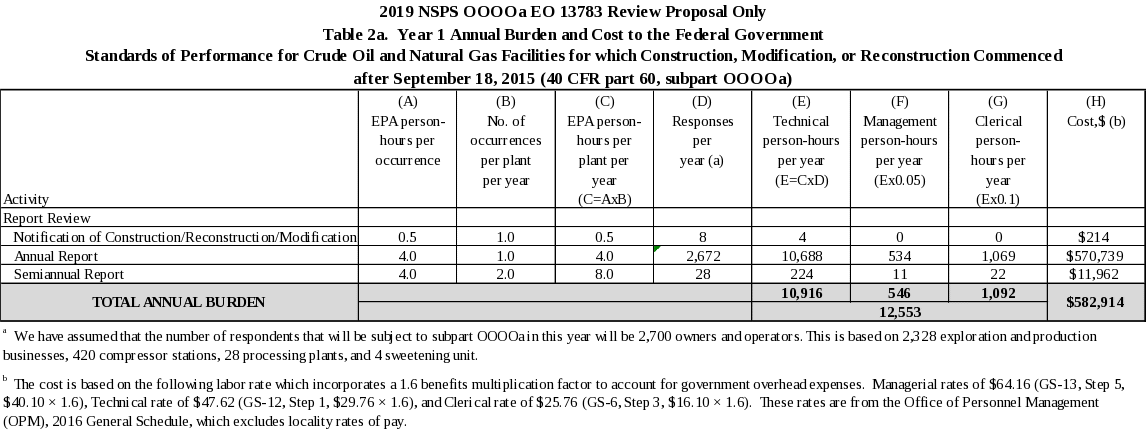
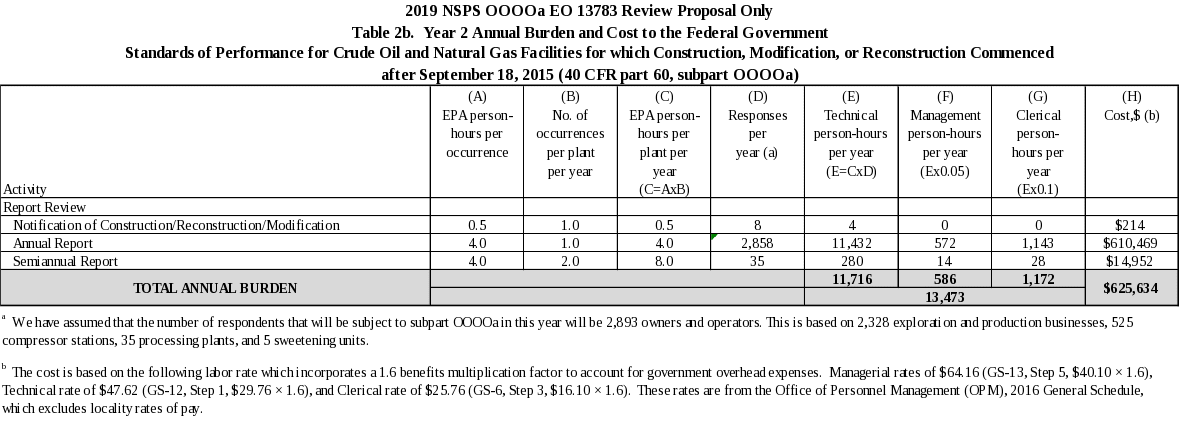


Appendix D
Draft Estimate of New Sources Affected for purposes of the Information Collection Request under the Proposed Amendments to 40 CFR Part 60, Subpart OOOOa.
DRAFT MEMORANDUM
TO: EPA Docket No. EPA-HQ-OAR-2017-0483
DATE: March 7, 2019
SUBJECT: Draft Estimate of New Sources Affected for purposes of the Information Collection Request under the Proposed Amendments to 40 CFR Part 60, Subpart OOOOa.
INTRODUCTION
On June 3, 2016, the Environmental Protection Agency (EPA) published a final rule titled “Oil and Natural Gas Sector: Emission Standards for New, Reconstructed, and Modified Sources; Final Rule” (81 FR 35824). Following promulgation of this rule, which is contained in 40 CFR part 60, subpart OOOOa, EPA received petitions for reconsideration and EPA granted reconsideration on several issues. In addition, the March 2017 Executive Order 13783 required EPA to evaluate subpart OOOOa with attention to whether the rule “unduly burden[s] the development of domestic energy resources beyond the degree necessary to protect the public interest” and, if so, appropriately “suspend, revise, or rescind” regulatory requirements. As revisions are proposed by EPA in response to this reconsideration and review, it is necessary to estimate the impact on the burden associated with information collection activities to comply with the Paperwork Reduction Act. The purpose of this supplemental memorandum is to present a summary of the methodology followed to estimate the number of certain new sources that would be affected facilities subject to subpart OOOOa prior to any amendments and the results. The updated number of affected facilities results in a new baseline to estimate the burden impacts associated with any proposed changes to subpart OOOOa. Specifically, this memorandum presents the estimated number of pneumatic controllers, reciprocating compressors, and centrifugal compressors that have become subject to subpart OOOOa each year since the promulgation of the rule in 2016, and the number that will be expected in the future. These estimates are separated by those sources in the transmission and storage (T&S) and production and processing (P&P) segments of the industry. Section 2 provides the estimates of the number of new affected sources expected each year, and Section 3 provides the total number of sources that would be subject in the absence of any changes to the rule. Note that the number of facilities for purposes of identifying the burden of information collection activities is different that the number of facilities analyzed for purposes of the Regulatory Impact Analysis (RIA). While the burden associated with information collection is calculated for the total number of facilities reporting to comply with 40 CFR part 60, subpart OOOOa, for purpose of the RIA, main impacts are analyzed looking at the incremental changes of the standards that are changing.
SUMMARY OF POPULATION
Tables 2-1 provides a summary of the estimate of the number of new pneumatic controllers, reciprocating compressors, and centrifugal compressors that would be subject to the 2018 NSPS OOOOa annually for all segments of the industry, by source and segment. The methodology for these estimates is provided following the table.
Table 2-1. Estimate of New Sources Affected under the Proposed Amendments to
40 CFR Part 60, subpart OOOOa.
2018 New Affected Facilities per Year |
||||
Source |
T&S |
%T&Sa |
P&P |
All Segments |
Pneumatic Controllers |
308 |
20% |
1,234 |
1,542 |
Reciprocating Compressors |
76 |
15% |
422 |
498 |
Centrifugal Compressors (wet seal) |
18 |
70% |
8 |
26 |
aPercentage of population in the T&S segment in the most recent U.S. and Greenhouse Gas (GHG) Emissions and Sinks inventory (1990-2016).
To estimate the number of new sources shown in Table 2-1, the following approach was used:
The number of T&S sources was provided by EPA Economists. These numbers were estimated using the April 2018 release of the GHG Inventory. EPA estimated the number of each new source by averaging the increases in the year-to-year changes in total national counts of each set of equipment over the 10-year period from 2004 through 2014. Year-to-year increases were assumed to represent newly constructed facilities. Decreases in total counts were represented as zeros for that year and averaged together with the annual increases. This approach results in the same number of new sources in each projected year, regardless of increases or decreases in Annual Energy Outlook projected drilling or production. This approach may result in an underestimate of total new and modified sources for two reasons: (1) modifications are not captured, and (2) if sources are taken offline and replaced with new facilities, those would not be reflected in the net increase in the year-to-year total. The national equipment counts estimated in the GHG Inventory are not disaggregated by state, therefore, activity data using this approach is only estimated at the national level.
Activity data were obtained for petroleum and natural gas systems sources from Tables 3.5-5 and 3.6-7 of the Annexes of the most recent U.S. and Greenhouse Gas Emissions and Sinks inventory (https://www.epa.gov/ghgemissions/inventory-us-greenhouse-gas-emissions-and-sinks-1990-2016).
The 2016 activity data (the most recent available year) for pneumatic controllers, reciprocating compressors, and centrifugal compressors (wet seal from the production, processing, transmission, and storage segment were extracted from Tables 3.5-5 and 3.6-7 and totaled by source and by segment. A summary of the information extracted from Tables 3.5-5 and 3.6-7 is provided in Appendix A to this memorandum.
For each source (i.e., pneumatic controllers, reciprocating compressors, and centrifugal compressors (wet seal)), the fraction that exists in the T&S segment was calculated.
The fraction that exists in the T&S segment estimated in step 4 was applied to the number of T&S sources provided by EPA Economists to determine the total number of sources in all segments. The resulting total represents the number of sources in all segments including P&P.
Appendix A provides a spreadsheet that contains the relevant activity data extracted from the Annexes of the most recent Greenhouse Gas Emissions and Sinks inventory Tables 3.5-5 and 3.6-7.
SUMMARY
Tables 3-1 provides the estimated number of sources that would be subject to the 2018 NSPS OOOOa.
Table 3-1. Estimate of Total Number of Sources Affected under the Proposed Amendments to 40 CFR Part 60, subpart OOOOa.
Source |
New Affected Facilities Each Year |
Cumulative Number of Subject Sources |
||||||
2015 |
2016 |
2017 |
2018 |
2019 |
2020 |
2021 |
||
Pneumatic Controllers |
||||||||
Transmission & Storage |
308 |
308 |
308 |
308 |
308 |
308 |
308 |
308 |
Production & Processing |
1,234 |
1,234 |
1,234 |
1,234 |
1,234 |
1,234 |
1,234 |
1,234 |
Total |
1,542 |
1,542 |
1,542 |
1,542 |
1,542 |
1,542 |
1,542 |
1,542 |
Reciprocating Compressors |
||||||||
Transmission & Storage |
76 |
76 |
152 |
228 |
304 |
380 |
456 |
532 |
Production & Processing |
422 |
422 |
844 |
1,266 |
1,688 |
2,110 |
2,532 |
2,954 |
Total |
498 |
498 |
996 |
1,494 |
1,992 |
2,490 |
2,988 |
3,486 |
Centrifugal Compressors |
||||||||
Transmission & Storage |
18 |
18 |
36 |
54 |
72 |
90 |
108 |
126 |
Production & Processing |
8 |
8 |
16 |
24 |
32 |
40 |
48 |
56 |
Total |
26 |
26 |
52 |
78 |
104 |
130 |
156 |
182 |
APPENDIX A
Summary of Activity Data for Petroleum and Natural Gas Systems Sources Obtained from Tables 3.5-5 and 3.6-7 of the Annexes of the
2018 U.S. and Greenhouse Gas Emissions and Sinks inventory
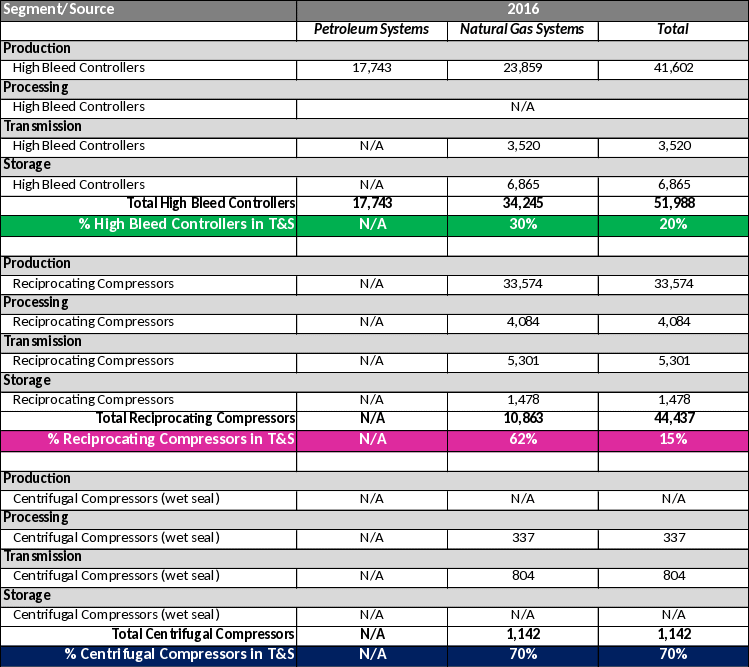
a 83 FR 52056
b These burden estimates will be updated when the NSPS OOOOa EO 13783 Review Amendments are finalized to reflect any changes made between proposal and promulgation, as well as to reflect the final rule changes resulting from the NSPS OOOOa reconsideration.
c The 2019 NSPS OOOOa EO 13783 Review Proposal package also includes minor amendments to the 2012 NSPS OOOO regarding storage vessel applicability for those vessels in the transmission and storage sector. However, these amendments do not have any impact on the information collection burden for NSPS OOOO.
d For example, paragraph 60.5420a(a)(2)(ii) states that “If you are subject to state regulations that require advance notification of well completions and you have met those notification requirements, then you are considered to have met the advance notification requirements of paragraph (a)(2)(i) of this section.”
e The updated baseline reflects updates to the estimated number of affected facilities according to the 2018 Inventory of U.S. Greenhouse Gas Emissions and Sinks (GHGI) and, for storage vessels, updated activity numbers included in the “Oil and Natural Gas Sector: Emission Standards for New, Reconstructed, and Modified Sources. Background Technical Support Document for the Proposed Reconsideration of the New Source Performance Standards, 40 CFR Part 60, subpart OOOOa. September 2018”.
| File Type | application/vnd.openxmlformats-officedocument.wordprocessingml.document |
| File Modified | 0000-00-00 |
| File Created | 2021-01-15 |
© 2025 OMB.report | Privacy Policy